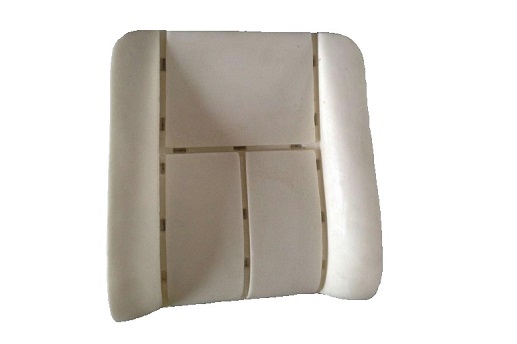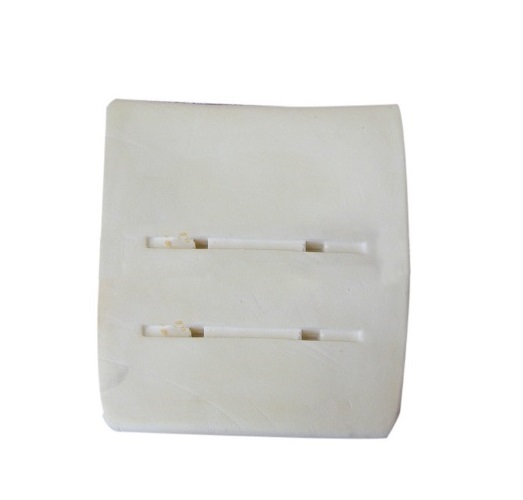Date of publication:2019-07-25 22:48:38 Article editor: Views:
Cold-cured high resilient polyurethane foam is an excellent cushion material. It has the advantages of good resilience, flame retardant and low production cost. But in the actual production process of high resilient foam, there are a series of defects, such as foam shrinkage, hollow bubble collapse, residual odor, poor surface porosity, poor moisture and heat aging performance. Henry technicians, based on years of production experience, summarized and explained the problems and solutions of high resilience products in production.
1. Foam shrinkage
In actual production, the most common and difficult problem is bubble shrinkage. The main causes of shrinkage are tooling, mould and raw materials, which complement each other.
1.1 Tooling Die
When the mold seal is not good, it is easy to cause leakage, so that the foam can not reach the designed density, resulting in foam shrinkage. At the same time, the foam products will produce hard edges near the corresponding mold lines. It can be solved by improving the sealing of the die mouth or properly improving the clamping force of the die.
1.2 Raw Materials
If the bubble film wall elasticity is larger during foaming process, when the volume of gas is large enough to expand, the bubble will expand at the same time without breaking up. Most of the bubbles will be closed pores, that is, the obturator rate is high. When the foam is cooled, the gas pressure in the bubble will decrease, resulting in the shrinkage and deformation of the foam. There are four solutions to this phenomenon.
(1) the pore size and opening rate can be controlled by adjusting the amount of catalyst. Usually, the amine catalyst mainly catalyzes the reaction of isocyanate with water (i.e. foaming reaction). Sanya ethyl two amine or organotin catalyst is mainly used to catalyze the reaction of isocyanate with Polyols (i.e. gel reaction). If the excess catalyst is promoted, the foam will be too early to gel, and the wall membrane of the bubble will have good toughness, and it will not break easily and form closed pores. In order to control foam pore size and opening rate, the amount of gel catalyst can be reduced appropriately, so as to reduce the growth rate of molecular chain, reduce the elasticity of bubble film wall and reduce the obturator rate at the peak of gas emission.
(2) The formation of closure is also related to the degree of polymerization and branching of polyether polyols. This is because in NCO/OH reaction, polyethers with high functionality form a network structure faster, that is, the elasticity of the cell wall is greater and the closure rate is increased. The average functionality of polyether can be reduced to reduce the obturator rate.
(3) the high dosage of foam stabilizer will result in too stable bubble hole, causing shrinkage without opening. Therefore, the amount of foam stabilizer should be used in production.
(4) when the isocyanate index is high, it may cause the phenomenon of foam closed hole to aggravate and cause shrinkage. Isocyanate index should be controlled during production.
2. Inside the foam, there are hollow and collapse bubbles.
In the production process of high resilience polyurethane foam, there are local hollow and collapse bubbles in the foam. There are two main reasons.
2.1 the reaction rate between gel and foam is not balanced.
In the final stage of the production of a large number of gases in foaming, the viscosity of the bubble membrane wall is relatively high, but the elasticity is poor. Thus, under the condition of increasing gas in the bubble, it can not bear the stretching of the membrane wall, resulting in bubble breakdown and gas escaping, i.e. opening. If the bubble wall ruptures when the gas occurs in large numbers, the channels and skeletons of the foams do not have enough strength to prevent the rupture, and the rupture will further spread, which will cause the entire foam to collapse. If the crack propagate to a small part to stop immediately, it will also cause the bubble to partially hollow or crack. In this case, if we increase the gel catalyst or reduce the amount of foaming catalyst and improve the balance between the gel and the foaming reaction, we can increase the intensity of the bubble film wall and reduce the amount of gas properly when the gas occurs a lot, so as to reduce or improve the phenomenon of hollow or collapse bubbles. This phenomenon is opposite to the closed cell shrinkage phenomenon. When the foaming catalyst remains unchanged and the amount of gel catalyst is low, it is easy to cause excessive opening and collapse.
2.2 the amount of foam stabilizer is low.
Silicone foam stabilizer is one of the essential raw materials in the process of polyurethane foaming. It can reduce the surface tension of various raw materials in the foam system, stabilize the foaming process, and make the pores thin and uniform. When the system is in the low viscosity stage, it can make the pore wall film grow to the thickness suitable for the opening, and create conditions for the final opening. If the amount of foam stabilizer is low, the stability of foam pores is poor, and premature opening will cause collapse or partial hollow.
Proper foam stabilizers can coordinate the opening time. The opening of cell holes is a major process in the high resilience foam process, otherwise the closed cell will shrink. However, the opening must occur when the foaming reaction and gel reaction are basically completed and reached equilibrium, that is, when the foam reaches the highest point and the foam strength can support its own weight, it will make the foam collapse or hollow.
3 foam has residual odor.
The residual odor in foam may come from three aspects.
(1) when the isocyanate is too high, there will be residual toluene diisocyanate in the foam formed, resulting in pungent odor.
(2) If there are more volatiles in the polyether selected from the raw material formulation, it may have a "polyether flavor" after foaming.
(3) the amine odor caused by residual amine catalyst in foam is larger. There are two ways to solve this odor. One is that the foam can be stored in a high temperature for a period of time, so that the residual catalyst in the foam will evaporate, but it is difficult to operate in practice. Second, adding amine catalyst that can participate in the chemical reaction of foam system can reduce the amine smell caused by conventional amine catalyst, but at the same time, the cost of foam should be raised correspondingly.
4 there are pores on the surface of foam products.
There are pores on the surface of foam products, or there are dark holes inside. These phenomena can be mainly caused by 5 reasons.
(1) the surface roughness of the mold is not enough, which affects the fluidity of the material system and makes the surface of the foam rough and porous. This mainly depends on improving the surface smoothness of the die, careful operation and better release agent.
(2) if the viscosity of the material system is too high and the fluidity is poor, it will cause bubbles on the surface of the foam products. This is mainly solved by reducing the viscosity of the composite polyether. The suitable viscosity in practical work is 1500-1800mPa.s.
(3) if the gel speed is fast and the time is too short in the foaming process, the viscosity of the material system will increase rapidly and the fluidity will become worse. Gel time is generally controlled at 55-65s. But the gel time should not be too long. Otherwise, if the sealing of the die does not meet the requirements, it will cause waste of raw materials.
(4) The initial foaming speed is too fast. Generally speaking, when the raw material is evenly covered with the inner surface of the bottom of the mold, it will rise quickly and the foam will have a good surface quality. If the raw material is not flowing to the surface of the mold, then it will be foamed. Instead, the material will be expanded to this point by rapid lifting. Therefore, the lifting time should be prolonged appropriately. Generally controlled in 10-15s. However, this time is greatly affected by the amount of catalyst used in actual production and feed temperature model temperature, so the feed temperature and die temperature should be strictly controlled in life, and the general feed temperature should be controlled at 22-24 C.
(5) The design of the exhaust hole of the die is inappropriate. Generally speaking, the exhaust holes of the die should be as small and as many as possible, and the positions should be distributed at the highest point of the foaming die and the closing line. The exhaust holes can divert the material system. Reasonable distribution of exhaust holes can minimize bubbles or dark holes. At the same time, in the actual production, the design of pouring route should also match the distribution of exhaust holes. In the production of cushion, if the raw materials are poured in two places at the same time, the exhaust holes should be arranged above the confluence of the two raw materials as far as possible to avoid the formation of dark holes.
5. Poor hygrothermal aging performance
The moisture and heat aging properties of cushion foam are a more demanding test of Volkswagen's VW50180 standard. Formerly used mainly in BORA A4 seat foam detection, now is about to carry out this test on the JETTA seat foam. The test is to store the foam in the relative humidity of 95%-100% and 90 degrees, and then compress the foam 50% in the oven at 70 degrees, store the 22h, then remove it and place it in 0.5h. After measuring it, the deformation of the 200H is not greater than 15%.
The reason of affecting the wet-heat aging property is mainly related to the isocyanate index.
(1) in the actual production, when the isocyanate index is low, the moisture and heat performance of the foam will become worse.
Normally, the amount of isocyanate in general should be slightly higher than that in theory, and the isocyanate index should be 1.05, so that the end group of the chain growth reaction product should be NCO.
Namely nOCN-R-NCO+(n-1)HO-R'-OH→OCN-R-NHCOO-R'-OCONH-R-NCO
When the isocyanate dosage is lower than the theoretical dosage, the end of the macromolecule obtained by chain growth reaction is hydroxyl. The hydroxyl group has strong hydrophilicity, which leads to the decrease of foam resilience in damp heat state, that is, the hygrothermal aging property. This is also the reason why foam tends to become soft and deformed in the summer when it is rainy or in the south where humidity is high and temperature is high.
(2) if the isocyanate index is above 5% of normal value, NCO can react with the water in the air because of the excess of NCO. There are too many ureas in the foam, resulting in stiff hand feeling and low resilience, which can also lead to poor heat and moisture aging properties of the foam.
6. Summary
Foam defects are mainly affected by raw material formulation, tooling status, and process parameters control. In order to effectively reduce foam defects, various factors should be considered comprehensively.
TOP